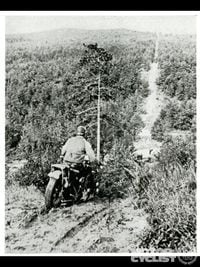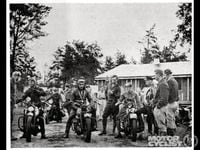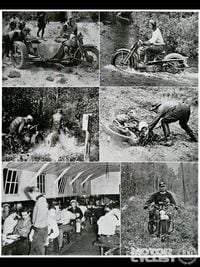From the August 1939 issue of Motorcyclist Magazine
The accompanying yarn gives an outsider’s impression of the Jack Pines run. Eldon Robbins is assistant editor of the Michigan Educational Journal. He arranged to ride over parts of the course as a sidecar passenger with Oscar Lenz who has several times been the winner of the famous run. In giving this account of the run Mr. Robbins not only indicates its interest to a layman but at the same time indicates how tough it was for the actual contestants.-Ed.
Among all events which pit men and machines against the barriers of nature, the Jack Pine run is “tops.” You don’t actually have to ride the run yourself to prove this. Just follow it along on side roads, ducking in when you can to watch the boys come through. You’ll see plenty-enough to make you marvel at the stamina of the machines and the pluck and skill of the lads who pilot them.
Did we say “lads”? Pardon us, Mrs. Earl Robinson of Detroit. It should have been “lads and lassy.” For Mrs. Robinson rode the Jack Pine run we followed, and she rode it right well. Good enough to win fifth place in the event in which she competed.
When Mother Nature was sculpturing what are now the cut-over pine lands of Northern Michigan, she must have had her mind on other matters. Or, perhaps she foresaw the Jack Pine run. In any event, she strewed her materials about in a most careless way.
The hills, for instance, are sandy and so steep that no self respecting deer would be caught climbing one. Not, that is, unless some scarlet coated hunter was pouring lead at him from a high powered rifle.
And the bogs and marshes which are in many of the valleys are really something for the books. This is Paul Bunyan country and they say Babe, the big blue ox, made these swamps and pot holes. Every place she plumped down her dainty hoof, they’ll tell you, she left a hole which became a lake which filled up with vegetation and is now a marsh.
But don’t you believe ‘em. It may be Paul Bunyan country, but Babe never made those swamps. Babe never had a hand in anything so ornery as these Northern Michigan swamps. If anyone is to blame for them, it’s the wicked Side-Hill Moodies and they left the long-billed mosquitoes to watch over them.
I’ve a hunch that the shade of Old Paul Bunyan is on hand for every Jack Pine run. It’s the sort of thing he’d revel in. To see those little fellows on their bikes roaring and tearing away at the big hills-and getting over them too, by golly! That’s what would tickle Old Paul.
If they’d had Jack Pine runs when Paul was lumbering off this country, you can bet your bottom dollar that he’d have entered a team of riders. And what’s more, Bunyan’s Bounders or Paul’s Pluggers, or whatever they might have been called. would have given a good account of themselves in the run or they would have answered to The Old Lumberjack.
Oscar Lenz, veteran Jack Pine rider who headed the party that laid out the course of the run, says that Mother Nature was really lavish in making things tough for motorcycle riders in Northern Michigan. He doesn’t say it in exactly that fashion, but you get the general idea.
After breezing along on pavement in Oscar’s sidecar for forty miles with the morning sun warming your back and the cock pheasants crowing and strutting about in the dew laden fields of corn, the first taste of the rougher stuff of the run is somewhat of a shock.
Oscar decided that we would sort of “duck in” to the run for a few minutes to catch some pictures of the boys navigating a trout stream just beyond the drowsy little Michigan town of Six Lakes.
So we turned off the nice smooth pavement onto a rutty country road. Oscar must have forgotten that we were only following the run because he “turned her on” as if we were thirty minutes late for the next check ahead. I never realized until after that ride into the trout stream how many unpadded places there are in what the boys inelegantly term a “side hack.”
There was plenty of action at the trout stream and the principal difficulty was trying to keep out of the way of it. The stream was narrow and the best vantage point for action shots was either in the water or right at its edge. But just as you would get all set for a shot, some wild-eyed rider would come “busting” over the bank and into the creek sending showers of icy water in every direction. Then too, there was one chap who “flopped” in the middle of the stream. It was a perfectly executed “flop” and it came just as I was changing films in my camera. This lack of cooperation on his part might have been attributed to carelessness, but his refusal to do it over again could only be classed as rudeness.
The next place we “ducked in” to the run was just south of Evart where Oscar said there would be some good stretches of deep sand. It was while on the way in to this spot that I learned another lesson on “How to Ride in a Side Hack and Come Back in One Piece.”
It’s quite proper for the passenger in the side car to bound out and start pushing the outfit when it gets stuck in a mud-hole. But if he pushes behind the drive wheel, he’s asking for it and he’ll very likely get it. At least I did.
But we did get to the sand hills and they were everything that could be asked for in the way of discouraging motorcycle riding. The sand was soft and deep and the sun blazed down upon the riders as they heaved and grunted and shoved and ate sand.
It was here that Oscar divulged his theme for laying out Jack Pine runs. You had to protect yourself against the weather man. If it turned off hot and dry, the sand stretches would make the going tough; and if it rained, the back roads in the farming sections would be a sea of mud. The course wanted to be tough, but not too tough, was the way Oscar put it.
When we reached Grayling that evening at the end of the first day of the run, we found that about half of the riders who started that morning had decided that Oscar’s interpretation of “tough going” was wrong. It was “too tough” so far as they were concerned.
I neglected to ask Oscar if the weather man ever crossed him up on his scheme for laying out the run. The answer came before morning when we were awakened by the sound of rain drumming on the barrack roofs.
Rain suits were very much in style as the riders left Camp Au Sable for the return trip to Lansing. A steady drizzle ha set in and the low spots in the road were flooded with water. By hitting these hard, Oscar explained, the water would fly right over our heads. And it did, all except a quart or so which sluiced up each sleeve.
When we reached the clay hills of West Branch and Gladwin, we saw that the weather man had really given the run both barrels. The mud wasn’t very deep, but it was the slitheriest I ever saw. But it was fair. It didn’t play any favorites, because the winners flopped just as ingloriously as the rest.
It was late afternoon when we drew up in the shadow of Michigan’s capitol building. I laboriously crawled out of the “side hack” and limped over to where the riders were checking in.
A bystander behind me watched the begrimed riders roll in on their mud spattered motorcycles and then inquired of his friend the amount of prize money involved.
“They don’t get any money,” his friend replied. “And first prize is an old cow bell.”
“An old cow bell?” The bystander wrinkled hi s brow in amazement. “They do this for an old cow bell? Thev must be nuts.”
“They may be ‘nuts’ to you, my friend.” I thought, “but there’s others that don’t agree.”
And I walked over to join some people whom I liked better, a crowd of Jack Piners.













/cloudfront-us-east-1.images.arcpublishing.com/octane/S35YGSEMEZB4BLTDJTSZPF4GLA.jpg)
/cloudfront-us-east-1.images.arcpublishing.com/octane/5UOT6HPX2JFMRJAX6EH45AR4MQ.jpg)
/cloudfront-us-east-1.images.arcpublishing.com/octane/OKWOJWAKP5EP3OACCRRWPCIX2Q.jpg)
/cloudfront-us-east-1.images.arcpublishing.com/octane/2WF3SCE3NFBQXLDNJM7KMXA45E.jpg)
/cloudfront-us-east-1.images.arcpublishing.com/octane/G4MG6OUCJNBSHIS2MVVOTPX65E.jpg)
/cloudfront-us-east-1.images.arcpublishing.com/octane/IIGGWFOTOJGB7DB6DGBXCCMTDY.jpg)
/cloudfront-us-east-1.images.arcpublishing.com/octane/QSTCM6AVEZA5JJBUXNIQ3DSOF4.jpg)
/cloudfront-us-east-1.images.arcpublishing.com/octane/U4I7G625B5DMLF2DVIJDFZVV6M.jpg)
/cloudfront-us-east-1.images.arcpublishing.com/octane/B6XD6LS6IVCQPIU6HXDJSM3FHY.jpg)
/cloudfront-us-east-1.images.arcpublishing.com/octane/ICL63FEDDRDTTMINYICCEYGMDA.jpg)
/cloudfront-us-east-1.images.arcpublishing.com/octane/FCGZHQXRBZFLBAPC5SDIQLVF4I.jpg)
/cloudfront-us-east-1.images.arcpublishing.com/octane/WNOB6LDOIFFHJKPSVIWDYUGOPM.jpg)

/cloudfront-us-east-1.images.arcpublishing.com/octane/X33NU3E525ECRHXLNUJN2FTRKI.jpg)
/cloudfront-us-east-1.images.arcpublishing.com/octane/6KKT5NNL2JAVBOXMZYS5ZO76YA.jpg)
/cloudfront-us-east-1.images.arcpublishing.com/octane/J5RKG5O455GMPGQRF2OG6LRT7A.jpg)
/cloudfront-us-east-1.images.arcpublishing.com/octane/GX2CIZKQVRH2TATDM26KFG2DAE.jpg)
/cloudfront-us-east-1.images.arcpublishing.com/octane/ZWIDYSAKQZHD5BHREMQILXJCGM.jpg)
/cloudfront-us-east-1.images.arcpublishing.com/octane/CYUHJZCTSJCH3MRAQEIKXK7SCQ.jpg)
/cloudfront-us-east-1.images.arcpublishing.com/octane/LKOFINY56FCXJCANJ5M7ZDQUBY.jpg)
/cloudfront-us-east-1.images.arcpublishing.com/octane/4NBPDACMWJH63JQYJVK3QRBDZI.jpg)
/cloudfront-us-east-1.images.arcpublishing.com/octane/KKHQHRR3FJGX7H2IPU6RALMWG4.jpg)

/cloudfront-us-east-1.images.arcpublishing.com/octane/5IOFS5JAE5FOXMNA23ZRAVVYUU.jpg)